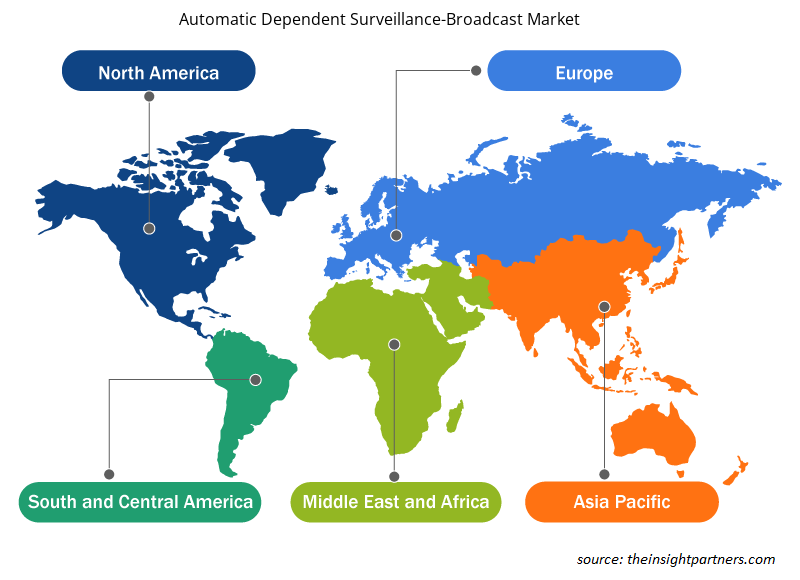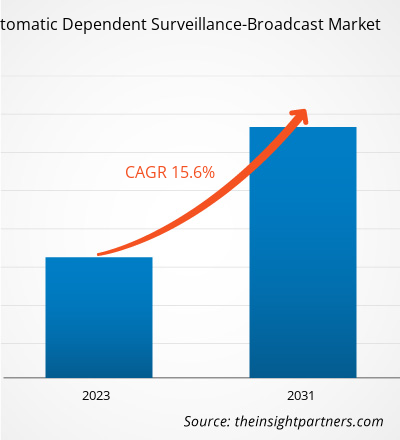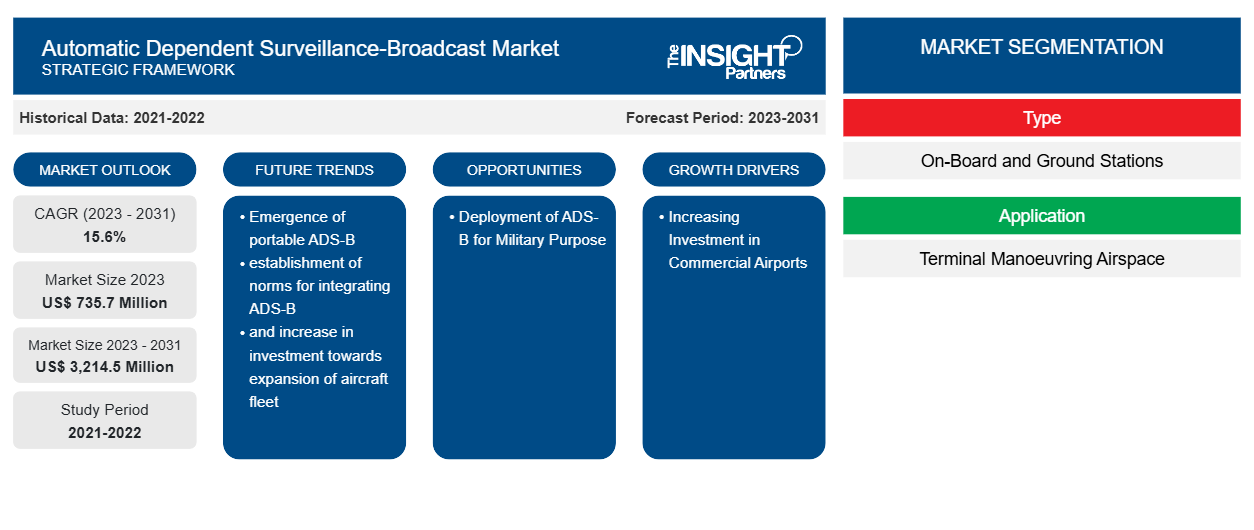Der Markt für automatische, abhängige Überwachungsübertragungen soll von 735,7 Millionen US-Dollar im Jahr 2023 auf 3.214,5 Millionen US-Dollar im Jahr 2031 anwachsen. Der Markt soll zwischen 2023 und 2031 eine durchschnittliche jährliche Wachstumsrate von 15,6 % verzeichnen. Die Einführung tragbarer ADS-B, die Festlegung von Normen für die Integration von ADS-B und die Erhöhung der Investitionen in die Erweiterung der Flugzeugflotte sind einige der wichtigsten Trends, die den Markt für automatische, abhängige Überwachungsübertragungen antreiben.CAGR of 15.6% in 2023–2031. The emergence of portable ADS-B, establishment of norms for integrating ADS-B, and increase in investment towards the expansion of aircraft fleet are among the key trends driving the automatic dependent surveillance-broadcast market.
Automatische, abhängige Überwachungs- und Rundfunkmarktanalyse
Die steigende Zahl von Flugzeugflottenbestellungen und -auslieferungen weltweit sowie die Vorschriften zur Verwendung von ADS-B spielen eine positive Rolle bei der Förderung der Einführung von ADS-B. Auch steigende Investitionen in die Aufrüstung kommerzieller Flughäfen mit modernen Einrichtungen und Technologien dürften die Einführung von ADS-B vorantreiben. Darüber hinaus dürften von den Luftfahrtbehörden von Ländern wie den USA genehmigte Projekte zur Verwendung von ADS-B in militärischen Anwendungen den Herstellern von ADS-B im Prognosezeitraum reichlich Wachstumschancen bieten. Auch die Einführung tragbarer ADS-B, die die Kosten für die Herstellung und Installation des Standard-ADS-B einspart, dürfte zum Marktwachstum beitragen.
Marktübersicht für automatische, abhängige Überwachungsübertragungen
ADS-B ist eine Überwachungstechnik, bei der keine externen Reize erforderlich sind. Diese Technik ist auf Flughafenfahrzeuge und Flugzeuge angewiesen, um ihre Position, Identität und andere Informationen zu übertragen, die von Bordsystemen wie GNSS stammen. ADS-B weist Merkmale wie hohe Leistung, Umweltverträglichkeit, globale Interoperabilität sowie erhöhte Kapazität und verbesserte Sicherheit auf. Darüber hinaus ist die ADS-B-Überwachungsinfrastruktur kostengünstiger als die primäre Radartechnologie , was sie für Überwachungszwecke kosteneffizient macht. Ein Anstieg der Investitionen in den Ausbau der Flugzeugflotten weltweit wird voraussichtlich das Wachstum des Marktes für automatische Überwachungsübertragungen im Prognosezeitraum vorantreiben. Darüber hinaus wird erwartet, dass die kommerzielle Luftfahrt in den kommenden Jahren aufgrund der steigenden Zahl von Flugreisenden und der Anschaffung neuer Flugzeuge zunehmen wird. In Nordamerika, Europa und im asiatisch-pazifischen Raum hat der Fluggastverkehr mit der Zeit zugenommen, was die Nachfrage nach Verkehrsflugzeugen ankurbelt. Im asiatisch-pazifischen Raum, vor allem in China und Indien, haben sich Verkehrsflugzeuge für Inlandsreisen als kosteneffizient erwiesen. Dies wird voraussichtlich das Marktwachstum in den kommenden Jahren ankurbeln.
Passen Sie diesen Bericht Ihren Anforderungen an
Sie erhalten kostenlos individuelle Anpassungen an jedem Bericht, einschließlich Teilen dieses Berichts oder einer Analyse auf Länderebene, eines Excel-Datenpakets sowie tolle Angebote und Rabatte für Start-ups und Universitäten.
-
Holen Sie sich die wichtigsten Markttrends aus diesem Bericht.Dieses KOSTENLOSE Beispiel umfasst eine Datenanalyse von Markttrends bis hin zu Schätzungen und Prognosen.
Markttreiber und Chancen für automatische, abhängige Überwachungsübertragungen
Steigende Investitionen in Verkehrsflughäfen
Mit der steigenden Zahl kommerzieller Flughäfen weltweit steigt auch die Nutzung von ADS-B. Diese Technologie wird derzeit in Regionen wie Europa, Nordamerika und Asien eingesetzt. Mit der wachsenden Infrastruktur kommerzieller Flughäfen oder der Renovierung bestehender Flughäfen steigt auch die Anzahl der Bodengeräte wie ATC-Terminals, sodass ADS-B zur Verfolgung von Flugzeugen genutzt wird. In Ländern wie China gehört der Chongqing Jiangbei International Airport (CQIA) zu den zehntgrößten Flughäfen und durchläuft einen erheblichen Ausbauplan. Durch Investitionen soll der Flughafen den Status eines internationalen Luftverkehrsknotenpunkts erhalten und bis 2035 der größte in Westchina sein. Ein weiterer Flughafen in China, in dessen Entwicklung investiert wird, ist der Beijing Daxing International Airport.ATC terminals, is also increasing, thus taking advantage of ADS-B for tracking aircraft. In countries such as China, Chongqing Jiangbei International Airport (CQIA) is among the 10th largest airports, which is undergoing a significant expansion plan. From investment, the airport is to receive international air hub status and will be the largest in western China by 2035. Another airport in China witnessing investment to develop an airport is Beijing Daxing International Airport.
SE Lithuanian Airports hat mit der Nordic Investment Bank einen Kreditvertrag über 81 Millionen US-Dollar (70 Millionen Euro) zur Modernisierung der drei wichtigsten Flughäfen Litauens unterzeichnet: Vilnius, Kaunas und Palanga. Solche Projekte zur Modernisierung von Flughäfen sollen die Einführung moderner Technologien wie ADS-B vorantreiben. Die folgenden Daten zeigen die Investitionen in den Bau/die Modernisierung/die Modernisierung von Flughäfen in Regionen wie Nordamerika (20 Milliarden US-Dollar), APAC (90,86 Milliarden US-Dollar), SAM (1,12 Milliarden US-Dollar) und MEA (42,92 Milliarden US-Dollar) für die Entwicklung ihrer Flughäfen.Palanga. Such projects related to the modernization of airports are projected to propel the adoption of advanced technologies, including ADS-B. The following data represents the investments in terms of constructing/upgrading/modernizing airports across regions such as North America to witness US$ 20 billion, APAC to see US$ 90.86 billion, SAM to experience US$ 1.12 billion, and MEA to US$ 42.92 billion for the development of their airports.
Die genannten Investitionen in den Bau neuer und die Modernisierung bestehender Flughäfen werden voraussichtlich den Einsatz moderner Überwachungstechniken zur besseren Verfolgung von Flugzeugen steigern . Sie leisten somit einen positiven Beitrag zur Einführung von ADS-B, das den Markt für automatische Überwachungsübertragungen vorantreibt.
Einsatz von ADS-B für militärische Zwecke
Der Anwendungsbereich von ADS-B wird erweitert, um eine präzise Verfolgung von Flugzeugen zu gewährleisten. Mit kontinuierlichen technologischen Fortschritten wird die Integration von ADS-B in Militärflugzeuge immer weiter vorangetrieben. Laut Angaben der US Air Force wird das Pentagon voraussichtlich 2.936 Flugzeuge mit ADS-B Out ausstatten, die dem FAA-Mandat entsprechen. Bis 2025 will das US-Verteidigungsministerium fast 62 % seiner Flugzeuge mit ADS-B (Out) ausstatten, darunter mehr als 67 % der Hubschrauber, 35 % der Kampfflugzeuge und 100 % der Mobilitäts-, Trainingsflugzeuge, Kommando- und Kontroll-/Nachrichtendienst-, Überwachungs- und Aufklärungsflugzeuge (C2/ISR). Laut Angaben der Air Force werden voraussichtlich fast 1.129 Hubschrauber, 259 C2/ISR-Flugzeuge, 923 Mobilitätsflugzeuge und 625 Trainingsflugzeuge mit ADS-B ausgerüstet sein. Im Verteidigungsministerium sind folgende Flugzeuge vorgesehen, die ADS-B Out erhalten sollen: Boeing C-17 Globemasters, Lockheed Martin UH-60 Black Hawk-Hubschrauber, C-130 und C-5-Transporter. Ein derart massiver Einsatz von ADS-B in der Militärluftfahrt dürfte das Wachstum des Marktes für automatische Überwachungsübertragungen nachhaltig beeinflussen.
Automatische abhängige Überwachung-Broadcast-Markt-Bericht Segmentierung Analyse
Schlüsselsegmente, die zur Ableitung der Marktanalyse für automatisch abhängige Überwachungssendungen beigetragen haben, sind Typ und Endbenutzer.
- Basierend auf dem Typ wurde der Markt für automatische, abhängige Überwachungsübertragungen in Bordstationen und Bodenstationen unterteilt. Das Segment der Bordstationen hatte im Jahr 2023 einen größeren Marktanteil.
- Basierend auf der Anwendung wurde der Markt für automatisch abhängige Überwachungsübertragungen in TMA-Überwachung (Terminal Manövering Airspace) und luftgestützte Überwachung unterteilt. Das Segment luftgestützte Überwachung hatte im Jahr 2023 einen größeren Marktanteil.
- Auf der Grundlage der Komponenten wurde der Markt in Antennen, Empfänger, Transponder und ADS-B-Bodenempfänger segmentiert. Das Transpondersegment dominierte den Markt im Jahr 2023.
Automatische abhängige Überwachung-Broadcast Marktanteilsanalyse nach Geografie
Der geografische Umfang des Marktberichts über automatische, abhängige Überwachungsübertragungen ist hauptsächlich in fünf Regionen unterteilt: Nordamerika, Europa, Asien-Pazifik, Naher Osten und Afrika sowie Südamerika.
Nordamerika dominierte 2023 den Markt für automatische Überwachungsübertragungen. Nordamerika ist die technologisch fortschrittlichste Region mit großen Volkswirtschaften wie den USA, Kanada und Mexiko. Diese Volkswirtschaften zeichnen sich durch einen höheren Lebensstandard, ein hohes verfügbares Einzeleinkommen und schnelle technologische Fortschritte in der Luft- und Raumfahrttechnik und im Flughafenbau aus. Die Region Nordamerika umfasst die weltweit größte Flotte an Verkehrs- und Verteidigungsflugzeugen. Die große Anzahl einsatzbereiter kommerzieller und militärischer Flotten im In- und Ausland, gepaart mit einem hohen durchschnittlichen Wert der zurückgelegten Passagiermeilen in der Region, trieb die Nachfrage nach Kommunikationskomponenten für Flughäfen und Flugzeuge an. Die Volkswirtschaften in der gesamten Region verfügen über eine beträchtliche Präsenz sowohl kommerzieller als auch militärischer Flughäfen. Einige rüsten ADS-B und zugehörige Systeme an diesen Flughafenstandorten für Anwendungen zum Empfang von Boden- und Flugzeugsignalen auf.
Regionale Einblicke in den Markt für automatisch abhängige Überwachungsübertragungen
Die regionalen Trends und Faktoren, die den Markt für automatische, abhängige Überwachungsübertragungen während des gesamten Prognosezeitraums beeinflussen, wurden von den Analysten von Insight Partners ausführlich erläutert. In diesem Abschnitt werden auch die Marktsegmente und die Geografie für automatische, abhängige Überwachungsübertragungen in Nordamerika, Europa, im asiatisch-pazifischen Raum, im Nahen Osten und Afrika sowie in Süd- und Mittelamerika erörtert.

- Erhalten Sie regionale Daten zum Markt für automatische, abhängige Überwachungsübertragungen
Umfang des Marktberichts über automatische abhängige Überwachungsübertragungen
| Berichtsattribut | Details |
|---|---|
| Marktgröße im Jahr 2023 | 735,7 Millionen US-Dollar |
| Marktgröße bis 2031 | 3.214,5 Millionen US-Dollar |
| Globale CAGR (2023 - 2031) | 15,6 % |
| Historische Daten | 2021-2022 |
| Prognosezeitraum | 2023–2031 |
| Abgedeckte Segmente |
Nach Typ
|
| Abgedeckte Regionen und Länder |
Nordamerika
|
| Marktführer und wichtige Unternehmensprofile |
|
Marktteilnehmerdichte: Der Einfluss auf die Geschäftsdynamik
Der Markt für automatische Überwachungsübertragungen wächst rasant, angetrieben durch die steigende Nachfrage der Endnutzer aufgrund von Faktoren wie sich entwickelnden Verbraucherpräferenzen, technologischen Fortschritten und einem größeren Bewusstsein für die Vorteile des Produkts. Mit steigender Nachfrage erweitern Unternehmen ihr Angebot, entwickeln Innovationen, um die Bedürfnisse der Verbraucher zu erfüllen, und nutzen neue Trends, was das Marktwachstum weiter ankurbelt.
Die Marktteilnehmerdichte bezieht sich auf die Verteilung der Firmen oder Unternehmen, die in einem bestimmten Markt oder einer bestimmten Branche tätig sind. Sie gibt an, wie viele Wettbewerber (Marktteilnehmer) in einem bestimmten Marktraum im Verhältnis zu seiner Größe oder seinem gesamten Marktwert präsent sind.
Die wichtigsten Unternehmen auf dem Markt für automatisch abhängige Überwachungsübertragungen sind:
- Avidyne Corporation
- Aspen Avionics, Inc.
- Collins Luft- und Raumfahrt
- FreeFlight-Systeme
- Garmin Ltd
- Honeywell International Inc.
Haftungsausschluss : Die oben aufgeführten Unternehmen sind nicht in einer bestimmten Reihenfolge aufgeführt.

- Erhalten Sie einen Überblick über die wichtigsten Akteure auf dem Markt für automatische, abhängige Überwachungsübertragungen
Marktnachrichten und aktuelle Entwicklungen zur automatischen, abhängigen Überwachung – Rundfunk
Der Markt für automatische, abhängige Überwachungssendungen wird durch die Erfassung qualitativer und quantitativer Daten nach Primär- und Sekundärforschung bewertet, die wichtige Unternehmensveröffentlichungen, Verbandsdaten und Datenbanken umfasst. Im Folgenden finden Sie eine Liste der Entwicklungen auf dem Markt für automatische, abhängige Überwachungssendungen und Strategien:
- Im Juni 2023 führten Aireon und NAV Portugal das weltraumgestützte ADS-B ein. Damit werden nun über 75 % des Luftraums der ICAO-Region Nordatlantik auf der Grundlage einer Echtzeit-Flugverkehrsüberwachung kontrolliert.
- Im November 2020 ging Aireon eine Partnerschaft mit der Federal Aviation Administration ein. Diese Partnerschaft zielte auf die Erforschung der weltraumgestützten ADS-B-Datenexploration ab und stärkte damit die Position des Unternehmens auf diesem Markt.
Marktbericht zu automatischer, abhängiger Überwachung – Abdeckung und Ergebnisse
Der Bericht „Marktgröße und Prognose für automatisch abhängige Überwachungsübertragungen (2021–2031)“ bietet eine detaillierte Analyse des Marktes, die die folgenden Bereiche abdeckt:
- Marktgröße und Prognose auf globaler, regionaler und Länderebene für alle wichtigen Marktsegmente, die im Rahmen des Projekts abgedeckt sind
- Marktdynamik wie Treiber, Beschränkungen und wichtige Chancen
- Wichtige Zukunftstrends
- Detaillierte Porter's Five Forces Analyse
- Globale und regionale Marktanalyse mit wichtigen Markttrends, wichtigen Akteuren, Vorschriften und aktuellen Marktentwicklungen
- Branchenlandschaft und Wettbewerbsanalyse, einschließlich Marktkonzentration, Heatmap-Analyse, prominenten Akteuren und aktuellen Entwicklungen
- Detaillierte Firmenprofile mit SWOT-Analyse
- Historische Analyse (2 Jahre), Basisjahr, Prognose (7 Jahre) mit CAGR
- PEST- und SWOT-Analyse
- Marktgröße Wert/Volumen – Global, Regional, Land
- Branchen- und Wettbewerbslandschaft
- Excel-Datensatz
Aktuelle Berichte
Verwandte Berichte
Erfahrungsberichte
Grund zum Kauf
- Fundierte Entscheidungsfindung
- Marktdynamik verstehen
- Wettbewerbsanalyse
- Kundeneinblicke
- Marktprognosen
- Risikominimierung
- Strategische Planung
- Investitionsbegründung
- Identifizierung neuer Märkte
- Verbesserung von Marketingstrategien
- Steigerung der Betriebseffizienz
- Anpassung an regulatorische Trends























 Kostenlose Probe anfordern für - Markt für automatische, abhängige Überwachungsübertragungen
Kostenlose Probe anfordern für - Markt für automatische, abhängige Überwachungsübertragungen